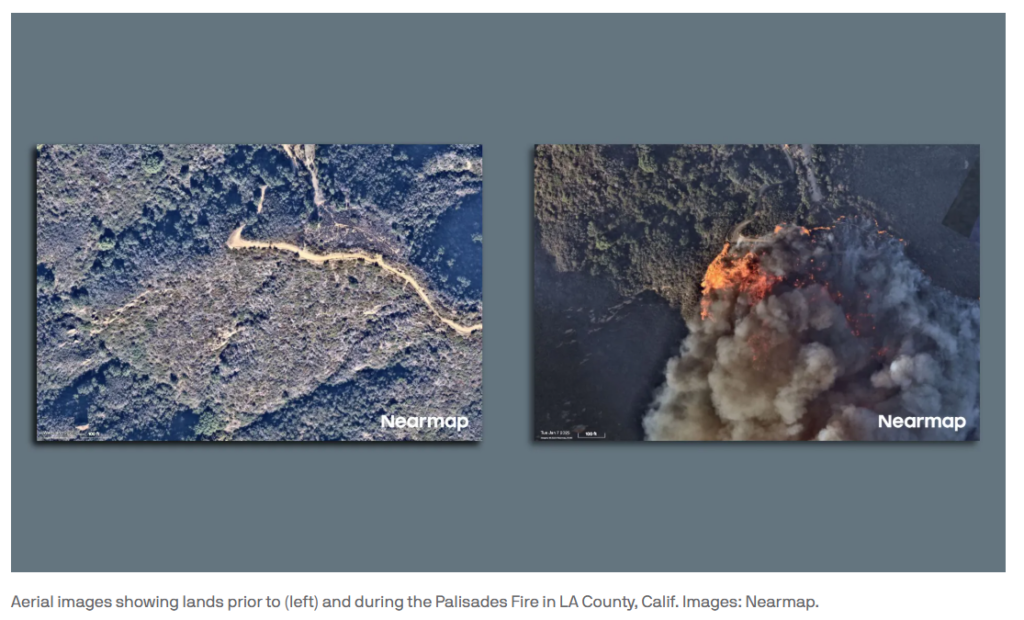
Climate change — particularly whiplash between two wet winters followed by a bone-dry, unusually hot spring, summer and fall — set the stage for Los Angeles’ deadly and devastating fires, scientists say.
- The firestorm was the product of what climate researchers refer to as “hydroclimate whiplash.”
- Other factors include one of the worst Santa Ana wind events of the past two decades; land use patterns; and sparks set off by power lines, car engines, suspected arsonists and other potential ignition sources.
Why it matters: Whatever the source, it’s clear a changing climate made the fires more ferocious, long-lasting and destructive, as has been the trend across the West in recent decades.
Threat level: Though winds are no longer as strong, the overall conditions that led to the extraordinary rates of fire spread haven’t abated.
- That may only come with significant rainfall, which currently isn’t in sight.
Zoom in: Hydroclimate whiplash occurs when one extreme precipitation regime is replaced by another.
- In this case, extremely wet conditions are followed almost immediately by parched weather patterns, typically accompanied by above average temperatures.
- This leads to a green up of vegetation that then dries out through evaporation, leading to ample “fuels” for a blaze to burn.
- The strong winds — which reached 99 mph in some locations — acted as an “atmospheric blow dryer” on trees and other vegetation, further drying out the landscape and ensuring any fire wouldn’t stay small for long, UCLA climate scientist Daniel Swain said in an online video briefing.
Stunning stat: In downtown Los Angeles, just 0.16 inches of rain has fallen since May 6, compared to the average of greater than 4 inches, per the National Weather Service.
- This is the city’s second-driest May 6 to Dec 31 period on record, according to the National Weather Service’s Los Angeles forecast office.
- No rain is in the forecast through early next week, with one Santa Ana event diminishing this morning, and another potentially strong one forecast for early in the coming week.
Zoom out: The see-saw pattern between wet and dry periods isn’t new for Californians. But these swings are becoming acute — and not just in the Golden State.
- A new study published last week shows these swings are becoming more of a trigger for wildfires, floods and drought globally.
- In the study, scientists refer to an increasingly “expanding atmospheric sponge,” since the atmosphere is able to evaporate, absorb and release 7% more water vapor for every 1°C (1.8°F) that the temperature increases.
In other words, the atmosphere gets more thirsty as the climate warms, drawing more moisture from plants, and leading to more days with extreme fire weather conditions.
- This analogy captures the atmosphere’s ability to absorb a larger and larger amount of water vapor as temperatures increase, and wring out more and more water due to such temperature changes.
- Data shows this whiplash effect has increased by between 31% to 66% globally since the mid-20th century, and that the rate of increase is speeding up.
Between the lines: If global average temperatures increase by about 3°C (5.4°F) — which is currently likely — then the whiplash effect will more than double in its intensity.
- “Increasing hydroclimate whiplash may turn out to be one of the more universal global changes on a warming Earth,” Swain said in a statement.
- Though the rare, powerful winds are fanning the blazes, it’s the whiplash-driven lack of rain that has trapped Southern California in a seemingly never-ending fire season.
- In addition to the increased thirstiness of the atmosphere and see-sawing from floods to droughts and back again, studies show that climate change is increasing the odds that windy periods occurring deeper into the traditional “rainy season” will overlap with extreme dryness.
- This overlap is another crucial tie between the ongoing California fires and long-term, human-caused climate change.
The intrigue: Land management, the use of prescribed burns and expanding building in fire-prone areas have also contributed to this wildfire nightmare. But climate change is a large, and growing factor.
- “Whether we like it or not, the nature of wildfire in Southern California is changing and we must adapt accordingly,” said UCLA climate scientist Alex Hall in a statement.
- “That will involve some frank conversations about the tradeoffs involved in improving our strategies to reduce ignitions, improve stewardship of our unique chaparral landscapes to reduce impacts, and protect human life and property.”
The bottom line: Climate change didn’t provide the spark that caused each of these catastrophic fires in LA County. But it’s making such fires worse.
Article Credit: axios